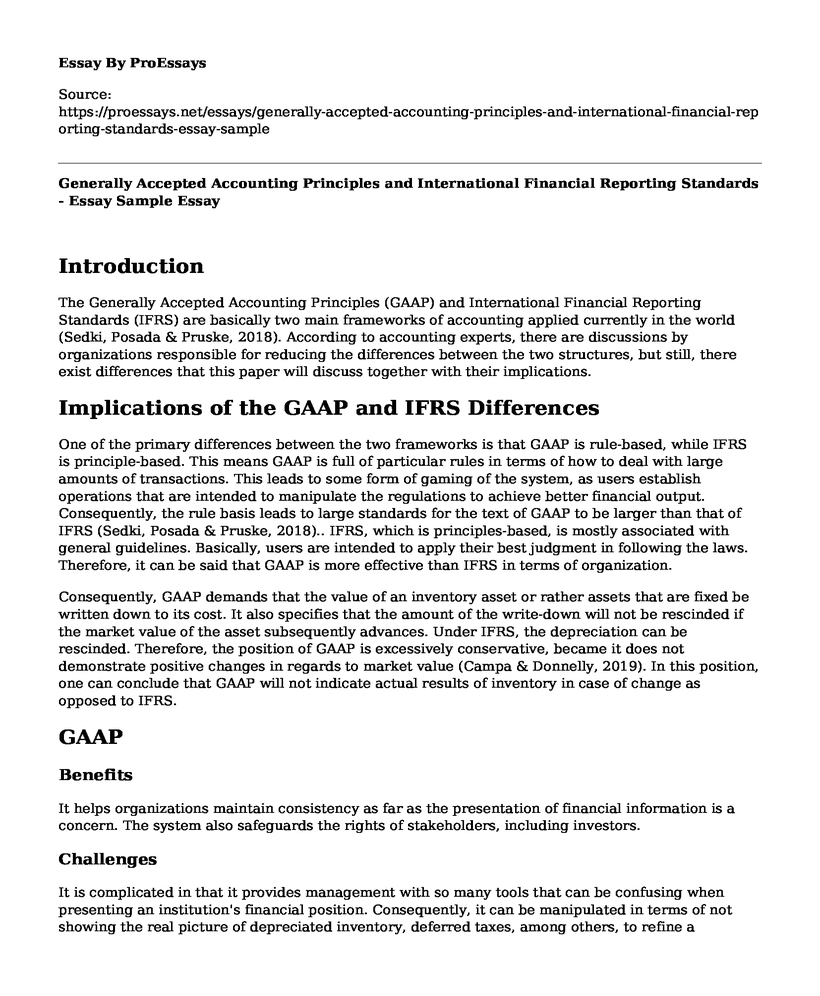Introduction
The Generally Accepted Accounting Principles (GAAP) and International Financial Reporting Standards (IFRS) are basically two main frameworks of accounting applied currently in the world (Sedki, Posada & Pruske, 2018). According to accounting experts, there are discussions by organizations responsible for reducing the differences between the two structures, but still, there exist differences that this paper will discuss together with their implications.
Implications of the GAAP and IFRS Differences
One of the primary differences between the two frameworks is that GAAP is rule-based, while IFRS is principle-based. This means GAAP is full of particular rules in terms of how to deal with large amounts of transactions. This leads to some form of gaming of the system, as users establish operations that are intended to manipulate the regulations to achieve better financial output. Consequently, the rule basis leads to large standards for the text of GAAP to be larger than that of IFRS (Sedki, Posada & Pruske, 2018).. IFRS, which is principles-based, is mostly associated with general guidelines. Basically, users are intended to apply their best judgment in following the laws. Therefore, it can be said that GAAP is more effective than IFRS in terms of organization.
Consequently, GAAP demands that the value of an inventory asset or rather assets that are fixed be written down to its cost. It also specifies that the amount of the write-down will not be rescinded if the market value of the asset subsequently advances. Under IFRS, the depreciation can be rescinded. Therefore, the position of GAAP is excessively conservative, became it does not demonstrate positive changes in regards to market value (Campa & Donnelly, 2019). In this position, one can conclude that GAAP will not indicate actual results of inventory in case of change as opposed to IFRS.
GAAP
Benefits
It helps organizations maintain consistency as far as the presentation of financial information is a concern. The system also safeguards the rights of stakeholders, including investors.
Challenges
It is complicated in that it provides management with so many tools that can be confusing when presenting an institution's financial position. Consequently, it can be manipulated in terms of not showing the real picture of depreciated inventory, deferred taxes, among others, to refine a company's picture, thus misleading investors.
IFRS
Benefits
It brings improved comparability to other institutions in a particular industry, thus making an institution more competitive with its peers. It can also lead to improved financial reporting and tax planning.
Challenges
There are difficulties, especially when applying the fair value concept. Consequently, it always needs extensive training and consultation for one to use it effectively. In conclusion, GAAP and IFRS have revolutionized financial reporting systems across the world to protect business investors.
References
Campa, D., & Donnelly, R. (2019). The Use of Asset Sales to Manage Earnings: Differences Between UK and US Companies and Between US GAAP and IFRS. Available at SSRN 3379645.
Sedki, S. S., Posada, G. A., & Pruske, K. A. (2018). Differences Between US GAAP and IFRS in Accounting for Goodwill Impairment and Inventory: Tax Treatment Under the Internal Revenue Code. Journal of Accounting and Finance, 18(4).
Cite this page
Generally Accepted Accounting Principles and International Financial Reporting Standards - Essay Sample. (2023, May 18). Retrieved from https://proessays.net/essays/generally-accepted-accounting-principles-and-international-financial-reporting-standards-essay-sample
If you are the original author of this essay and no longer wish to have it published on the ProEssays website, please click below to request its removal:
- Two Investment Projects Analysis
- Case Study Example: USEC Inc. Executive Summary
- The Affordable Care Act (ACA) and the Consumption Tax Paper Example
- Impact of IMF, WB on Municipal Finances - Essay Sample
- Essay Example on VW Group's Steady Rise in Revenue: 252 Billion Euros in 2019
- Filing a Dispute to Amendment Assessment and Limits
- Paper Example on The Healthcare Debate







